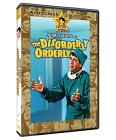| Reviews & Columns |
|
Reviews DVD TV on DVD Blu-ray 4K UHD International DVDs In Theaters Reviews by Studio Video Games Features Collector Series DVDs Easter Egg Database Interviews DVD Talk Radio Feature Articles Columns Anime Talk DVD Savant Horror DVDs The M.O.D. Squad Art House HD Talk Silent DVD
|
DVD Talk Forum |
|
|
| Resources |
|
DVD Price Search Customer Service #'s RCE Info Links |
|
Columns
|
|
|
Disorderly Orderly, The
This time Jerry plays Jerome Littlefield, the disorderly orderly of the title, at the Whitestone Hospital & Sanitarium. Jerome wants to go to medical school and become a doctor, but can't overcome a severe empathetic disorder. When, for instance, patient Mrs. Fuzzibee (Alice Pearce) describes her maladies in gruesome clinical detail, especially tales of her weak kidneys, poor Jerome's own kidneys begin to quiver, sending him scrambling for the nearest restroom. (Whattya expect from a Jerry Lewis movie, sophistication?)
Jerome is dating pretty nurse Julie Blair (Karen Sharpe, later Mrs. Stanley Kramer), but becomes fixated on a suicidal patient, Susan Andrews (Susan Oliver), whom Jerome had secretly loved when he was in high school and she was a popular cheerleader.
Mostly though, The Disorderly Orderly is simply an excuse to let Jerry Lewis run amuck in a hospital environment. The gags run the gamut from clever and funny to labored and obvious. He chases mental patient Fatty Jack (Jack E. Leonard), struggles with a plate of spaghetti (funny stuff here) and wreaks havoc in a pharmacy.
Some gags are straight out of Tashlin's cartoon repertoire. In one scene, when Jerry is caught in a strait-jacket and can hardly move, a snail races past him. The big chase finale, involving several ambulances, runaway stretchers and shopping carts, is a mini-gem and plays to Tashlin's strengths.
On the down side, Jerome's relationship with Susan is syrupy, cloying and, by today's standards, almost creepy. In his obsession, Jerome repeatedly sneaks into the woman's room, hovering over her at times like a slobbering stalker. Lewis had a weakness -- Chaplin's disease -- for such ham-fisted sentimentalism, but what worked so well in City Lights or The Circus is all thumbs in producer Jerry's hands. In one scene Oliver delivers a monologue as funny as anything in The Oscar (1966), at one point going into a long discourse likening love to atomic bombs: "Doctor, do you suppose I'm the victim of romantic fallout?" The picture's surreal art direction only adds to the unreality of Susan's condition; her hospital room actually has purple shag carpeting!
Tashlin and Lewis are on much safer ground in the comedy scenes, which are aided by Lewis's stock company of performers. Kathleen Freeman is a delight as a much-put-upon head nurse, and Barbara Nichols has one good scene as a demanding patient. Everett Sloane, in his last film role, plays a surprisingly contemporary hospital executive obsessed with gouging patients -- "You know our policy: no money, no bed!" (There's something to be said about an actor who began his film career sweetly reminiscing about a girl he never quite forgot in Citizen Kane, and ending it covered in red paint, strapped to a stretcher that flies off the end of Malibu Pier in The Disorderly Orderly.)
The picture makes good use of Greystone Park & Mansion, the familiar, oft-used Beverly Hills location, and features a title tune performed by Jerry's friend Sammy Davis, Jr.
Video & Audio
The Disorderly Orderly is a routine transfer in 16:9 anamorphic format, reflecting its original 1.85:1 aspect ratio. The image shows age-related wear in its first reel, but improves from the second reel forward. The Dolby Digital English mono track is fine; an alternate French mono track is included, along with English and Spanish subtitles.
Extra Features
There's no commentary track this time, a shame as it would have been nice to hear Lewis talk about working with Frank Tashlin. Included is a trailer, in 16:9 format complete with text and Davis's title song. Also included are roughly six minutes of outtakes, in 4:3 format and in black and white (the movie itself is color). These outtakes, often subtitled for clarity, feature mild profanity, so parents watching this DVD with their kids take note.
Parting Thoughts
Those not enamored of Jerry Lewis should avoid The Disorderly Orderly while those fond of his brand of slapstick will enjoy this bright, sometimes funny comedy, despite its weak scenes of melodrama.
Stuart Galbraith IV is a Los Angeles and Kyoto-based film historian whose work includes The Emperor and the Wolf -- The Lives and Films of Akira Kurosawa and Toshiro Mifune. His new book, Cinema Nippon will be published by Taschen in 2005.
|
| Popular Reviews |
| Sponsored Links |
|
|
| Sponsored Links |
|
|
| Release List | Reviews | Shop | Newsletter | Forum | DVD Giveaways | Blu-Ray | Advertise |
|
Copyright 2024 DVDTalk.com All Rights Reserved. Legal Info, Privacy Policy, Terms of Use,
Manage Preferences,
Your Privacy Choices | |||||||












